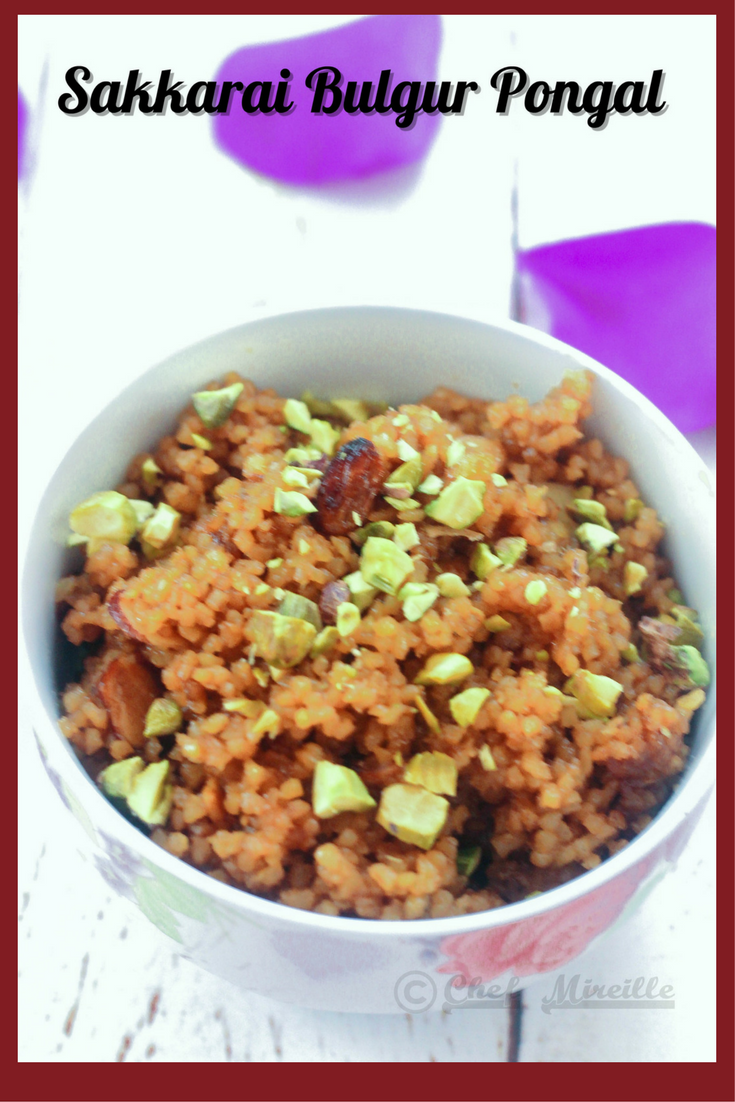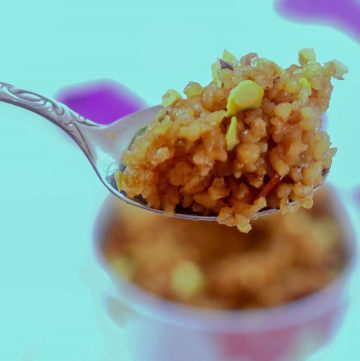Last Updated on October 19, 2024 by Chef Mireille
This low fat version of Sakkarai Pongal omits the ghee but still makes a delicious Indian sweet for any time.
This Indian sweet is one of many varieties of both sweet and savory pongal’s that are eaten around the festival of the same name. Pongal is a four day harvest festival celebrated in Tamil Nadu, Sri Lanka and other areas with large Tamil populations.

Before I even get started, let me first say this is a slightly non traditional version of pongal, but why not adapt recipes to out personal preference. Hope you like my version when you want to try something new.
Pongal is a harvest celebration in Sri Lanka and in southern India, specifically in Tamil Nadu. Pongal is not only the name of the festival but also the name of a food that is eaten not only during Pongal but throughout the year. Pongal, the food not the festival, can be made either sweet or savory and are usually grain based. When you see Sakkarai in the title, then you know it is a sweet pongal instead of a savory one. While rice is most common as the primary grain, there are also semolina (rava/sooji) and cracked wheat variations.
Here in the US, bulgur wheat is a lot more readily available. I used to use cracked wheat and bulgur synonymously but that is what is so great about the internet and the world of food blogging, you learn so much from others. They are actually not the same as bulgur wheat is pre cooked, therefore cooks much faster and requires less liquid than cracked wheat. People often comment how I am able to cook so many different cuisines. First of all, I am lucky to live in the global capital of the world where pretty much any ingredient is available, you just need to know where to look. Even cracked wheat I could have found, but if my pantry has a bunch of bulgur and they are so close in nature, why not utilize it?
Pongal occurs every year during the month of Thai in the Gregorian calendar. This year Pongal dates are January 14 – 17.
Let’s vicariously send ourselves to Tamil Nadu or Sri Lanka and partake in some Bulgur Pongal. It might help you think you are really there experiencing a different culture and cuisine. Imagine how much fun you are having! Too much wishful thinking? Well even if you can’t imagine yourself there, you can still enjoy this delicious dessert even if you are in NYC, albeit you are most likely freezing as you are eating it with the record low temperatures we have been experiencing for weeks now! Can you tell I am so ready for winter to be over!!!!
There are many variations of pongal. Here are just a few others you might like to try!
Savory Pongal Recipes
- Rava Pongal
- Ven Pongal (my all time fave Indian breakfast)
Sweet Pongal Recipes
How to Make Sakkarai Bulgur Pongal
Although traditionally it is often made with liberal amounts of ghee, I skipped it and still loved this slightly healthier version without the ghee, although my version is less creamy. Yet it was still super delicious!
Sakkarai Bulgur Pongal – Indian Bulgur Dessert
Ingredients
- 1 cup medium coarse bulgur
- 1 ½ cups water
- ½ cup milk
- 1 tablespoon ghee
- ½ tablespoon golden raisins
- 2 tablespoons sliced almonds
- 3 tablespoons pistacchios finely chopped (garnish) (optional)
- Jaggery Syrup Ingredients:
- ¾ cup powdered jaggery
- 2/3 cups water
Instructions
- In a saucepan, combine bulgur, water and milk. Bring to a boil. Reduce to a simmer and cook for 5 minutes, stirring occasionally, until all the liquid has been absorbed.
- In a small skillet, melt the ghee. Add raisins and almonds. Fry until raisins plump up. Remove from pan.
- In another saucepan or pot, add jaggery and water. Boil for about 4-6 minutes until you have a thin syrup consistency.
- Add cooked bulgur and toss. Cook for about 3-6 minutes. This is personal preference. Some pongal versions are more dry while others I’ve noticed are more wet closer to a porridge consistency. Ghee is usually also added which allows for a wetter texture.
- Add fried raisins and almonds. Stir to combine.
- To serve, garnish with the pistacchios.
Notes
TRADITIONAL INDIAN RECIPES
Travel to India on your plate every night of the week. Discover delicious Indian Recipes for every palate from every region of India with A LOT of Vegetarian options.







Awesome Mir, you are one person who can so easily adapt and cook different cuisines with ease and also talk about the culture behind it. This is so nicely done, I love how well the grains look separately and still nicely cooked!
thanks – glad you like it
That is a fantastic adaptation of the traditional pongal. Hats off to your passion.
thanks – glad you like my non traditional adaptation
I like this interesting version of the pongal, to make it more healthier and delicious too… bulgur is a very versatile ingredient…
so glad you like my healthier version..Thanks!
I agree with Valli. You adapt fast. Done an amazing job MIr.
thank you so much – I really appreciate the compliments coming from you guys on the other side of the Atlantic and beyond…
Beautifully cooked Pongal . Seriously I am drooling over that bowl , it looks nice and rich even though you did not load it with ghee :))
yes – new years resolutions right – this low fat version was just as delicious
great recipe with new ingredient.
thanks yes – adaptation is never something to be afraid of
thanks – yes bulgur can be quite an adaptable ingredient
Interesting take on sakkarai pongal,Mir. Nicely done and it looks very delicious!!!
thanks – although non traditional, it was still utterly delicious
thank you – and yes it was delicious although with a new twist
Wow, kudos to you for cooking sakarai pongal with bulgur wheat, excellent twist Mir. Lovely dish.
thanks – I am glad you liked my interpretation
thanks so much Priya
Thats awesome Mir and I totally second valli! You adapt to things effortlessly and it shows how much you enjoy what you are doing. This is an excellent variation to the traditional version. Food is to be enjoyed, so no harm in changing it according to our needs.
thanks I try – yes I thoroughly enjoyed my low fat version